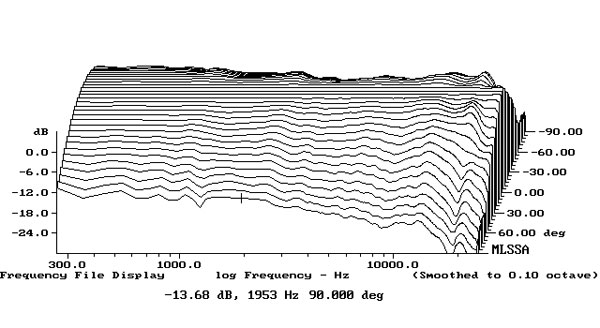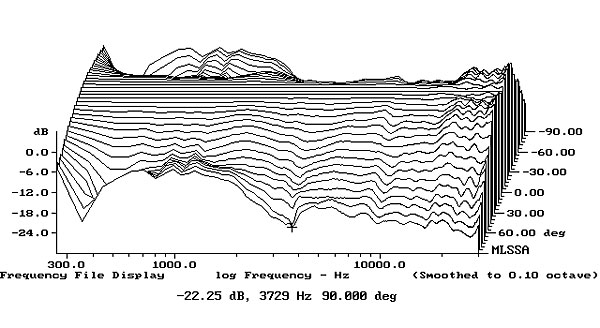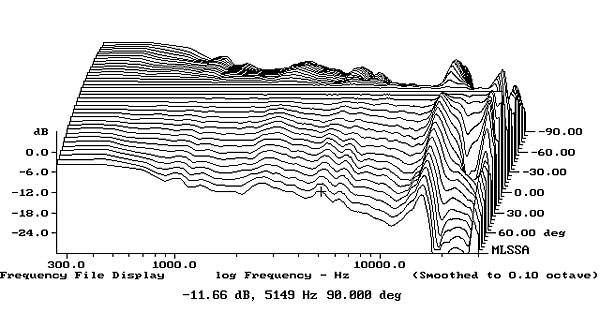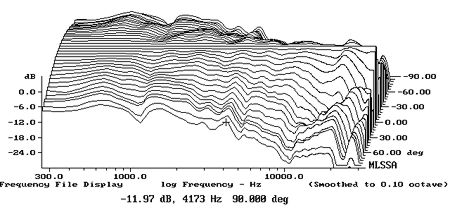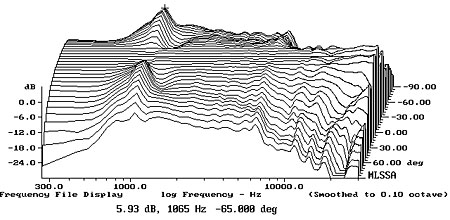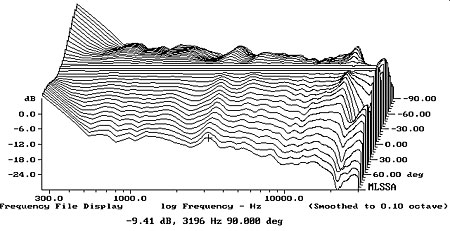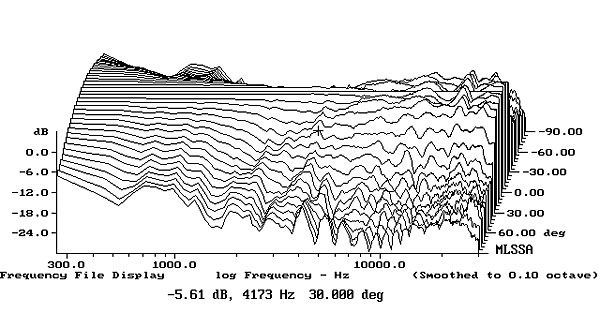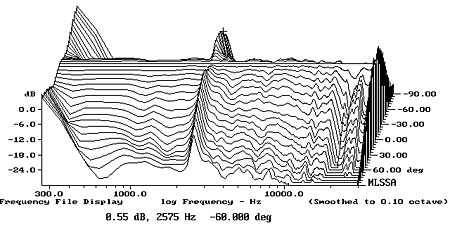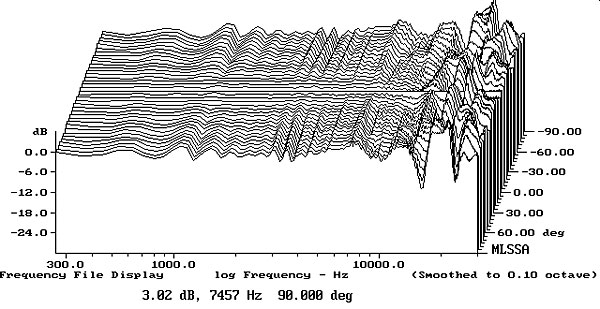The D&D 8C is one of those blessed few speakers with multiple sources of measurements out there, but as far as I know, none in spinorama form.
I'm having trouble with the bass summations, so I'm leaving them out for now. But in any case, there are already a variety of measurements out there, and I was mostly interested in presenting the directivity characteristics in a format we're more familiar with around here.
As usual, measurements made from 1m and gated at 6.5ms for maximum resolution within indoors measurements. Tested a few angles at 2m as well and no difference within the quasi-anechoic range that I can notice. Reference axis is between the tweeter and woofer, 26.5cm from the bottom as noted in the manual. While normally you would set the distance to the rear wall and sidewalls in the D&D app in order to take advantage of the speaker's boundary coupling effect, the speaker was set to its freestanding mode for this measurement.
Spin using 25dB per decade scale, as implied by CTA-2034A:

Remember this is a a different scale than Amir, who I believe is trying to matching the scale used by Harman in most of its spins. This slightly obscures some issues. Using Amir's/Harman's scale (based on m16 review), you get this:

Recently we've discussed some confusion about how early reflections are calculated (see here). You can see the visual impact it has with this speaker in the apparent smoothness of the ERDI curve in particular.

Horizontal Response 0 to 80 degrees in 10 degree intervals + Listening Window again:

Note how though the measurements only go down to about 200 Hz, you can see the cardioid directivity in how much lower the bass is in level
Presented differently, here's the polar map(1/6) normalized to the on axis. The lines represent 3dB drops

You can see it matches D&D's own polar map quite nicely, though they use a different scale and color gradients:

It's quite an audible effect too; when measuring it was pretty wild how much quieter the speaker is from behind than from in front.
One type of measurement we've been lacking on these is their vertical response, so here it is out to 15 degrees as well as the Ceiling and Floor reflections. As a recap, Ceiling reflections is an average of 40/50/60 above the reference axis, and Floor reflections is the average of 20/30/40 below the reference axis..
Note the on-axis measurement is slightly "messier" than in the horizontal charts as this required placing the speaker on its side to capture the vertical data. Still, it's useful for noting directivity characteristics.

I'd consider this a good result. The speaker is not very sensitive to changes in vertical height within the listening window, so you don't have to worry about keeping your head in a vice even when listening nearfield. Almost every speaker with vertically aligned drivers displays some kind of lobing, and I prefer the approach seen here, where the lobing is relatively narrow, as opposed to speakers with lobing covering a wider range of frequencies.
Taking a broader approach, here is the vertical response in polar map form.

Lastly, here is SPL Compression from 80dB to 100dB in room, as well as the same measurement converted to a quasi-anechoic one. In white is the deviation from linearity from 80 dB to 100dB.

It's hard to see exactly what's going on in the bass given room modes at my measurement location, but overall you can see there is little change in energy level at 100 dB. D&D claims the speakers 'max linear spl @1m' is 102B from 35Hz upwards. Unless you listen at crazy high volumes from very far away you are unlikely to get this speaker to compress.
Subjective thoughts:
The D&D 8c do just about everything right. My favorite thing about them is easily the bass. The built in EQ features based on the speaker distance to the wall have an immediate and obvious effect on their clarity. Once I inputted distances to the walls, they had the best bass presentation I've heard in my room without spending hours messing with REW and two subs. That said, you can mess around further with REW and load PEQs into each speaker to further refine the speakers, although I did not find a huge audible improvement. @mitchco covered that really well in his review so I don't feel the need to get into it.
My only real acoustic qualm with them is a personal one rather than a real criticism: I usually prefer wider-directivity designs. But here the 8c have an advantage too. The great off-axis response, cardioid directivity, and built-in EQ features mean you have a whole lot of flexibility for changing the spatial presentation. Don't use toe in and they sound more spacious. You even can toe them in 45 degrees for 'extreme' toe in and get a much more spacious sound akin to a wider directivity design.
On a non-acoustic front, I wish they had wi-fi or bluetooth. Not for playback, but because it's a pain to have to use ethernet to change settings if you want to put these in your living room. I had to use an extra router I had lying around to make a private network for the 8cs, as I was not able to plug them into my regular network without getting a ridiculously long ethernet cord or buying new networking equipment. Also, one of my review units had a board issue and required a replacement board to be shipped in. Luckily that was a simple repair that took all of 5 minutes.
Dr Toole likes to say something to the effect that the best speakers are not necessarily the ones that impress you the most, but rather the ones that are the least flawed. That defines the 8c in many ways. If you've been listening to good speakers for a long time and already take the effort to EQ your room properly, I do not think the D&D 8Cs will be some kind of golden eared sonic revelation. Instead, they are some of the most well thought out and versatile speakers out of the box I've ever tested. They are able to sound fantastic with a few seconds of tweaks no matter where you place the speakers, and you can rapidly change their sound with in-app tone controls and distance parameters. They are designed to be placed near walls, which is quite frankly something most speaker manufacturers should be doing. And personally, I think they are some good looking speakers too, especially in the white colorways.
At $12,500 a pair, one would hope they are good, of course. I'm going to miss them.
I'm having trouble with the bass summations, so I'm leaving them out for now. But in any case, there are already a variety of measurements out there, and I was mostly interested in presenting the directivity characteristics in a format we're more familiar with around here.
As usual, measurements made from 1m and gated at 6.5ms for maximum resolution within indoors measurements. Tested a few angles at 2m as well and no difference within the quasi-anechoic range that I can notice. Reference axis is between the tweeter and woofer, 26.5cm from the bottom as noted in the manual. While normally you would set the distance to the rear wall and sidewalls in the D&D app in order to take advantage of the speaker's boundary coupling effect, the speaker was set to its freestanding mode for this measurement.
Spin using 25dB per decade scale, as implied by CTA-2034A:
Remember this is a a different scale than Amir, who I believe is trying to matching the scale used by Harman in most of its spins. This slightly obscures some issues. Using Amir's/Harman's scale (based on m16 review), you get this:

Recently we've discussed some confusion about how early reflections are calculated (see here). You can see the visual impact it has with this speaker in the apparent smoothness of the ERDI curve in particular.
Horizontal Response 0 to 80 degrees in 10 degree intervals + Listening Window again:
Note how though the measurements only go down to about 200 Hz, you can see the cardioid directivity in how much lower the bass is in level
Presented differently, here's the polar map(1/6) normalized to the on axis. The lines represent 3dB drops
You can see it matches D&D's own polar map quite nicely, though they use a different scale and color gradients:
It's quite an audible effect too; when measuring it was pretty wild how much quieter the speaker is from behind than from in front.
One type of measurement we've been lacking on these is their vertical response, so here it is out to 15 degrees as well as the Ceiling and Floor reflections. As a recap, Ceiling reflections is an average of 40/50/60 above the reference axis, and Floor reflections is the average of 20/30/40 below the reference axis..
Note the on-axis measurement is slightly "messier" than in the horizontal charts as this required placing the speaker on its side to capture the vertical data. Still, it's useful for noting directivity characteristics.
I'd consider this a good result. The speaker is not very sensitive to changes in vertical height within the listening window, so you don't have to worry about keeping your head in a vice even when listening nearfield. Almost every speaker with vertically aligned drivers displays some kind of lobing, and I prefer the approach seen here, where the lobing is relatively narrow, as opposed to speakers with lobing covering a wider range of frequencies.
Taking a broader approach, here is the vertical response in polar map form.
Lastly, here is SPL Compression from 80dB to 100dB in room, as well as the same measurement converted to a quasi-anechoic one. In white is the deviation from linearity from 80 dB to 100dB.
It's hard to see exactly what's going on in the bass given room modes at my measurement location, but overall you can see there is little change in energy level at 100 dB. D&D claims the speakers 'max linear spl @1m' is 102B from 35Hz upwards. Unless you listen at crazy high volumes from very far away you are unlikely to get this speaker to compress.
Subjective thoughts:
The D&D 8c do just about everything right. My favorite thing about them is easily the bass. The built in EQ features based on the speaker distance to the wall have an immediate and obvious effect on their clarity. Once I inputted distances to the walls, they had the best bass presentation I've heard in my room without spending hours messing with REW and two subs. That said, you can mess around further with REW and load PEQs into each speaker to further refine the speakers, although I did not find a huge audible improvement. @mitchco covered that really well in his review so I don't feel the need to get into it.
My only real acoustic qualm with them is a personal one rather than a real criticism: I usually prefer wider-directivity designs. But here the 8c have an advantage too. The great off-axis response, cardioid directivity, and built-in EQ features mean you have a whole lot of flexibility for changing the spatial presentation. Don't use toe in and they sound more spacious. You even can toe them in 45 degrees for 'extreme' toe in and get a much more spacious sound akin to a wider directivity design.
On a non-acoustic front, I wish they had wi-fi or bluetooth. Not for playback, but because it's a pain to have to use ethernet to change settings if you want to put these in your living room. I had to use an extra router I had lying around to make a private network for the 8cs, as I was not able to plug them into my regular network without getting a ridiculously long ethernet cord or buying new networking equipment. Also, one of my review units had a board issue and required a replacement board to be shipped in. Luckily that was a simple repair that took all of 5 minutes.
Dr Toole likes to say something to the effect that the best speakers are not necessarily the ones that impress you the most, but rather the ones that are the least flawed. That defines the 8c in many ways. If you've been listening to good speakers for a long time and already take the effort to EQ your room properly, I do not think the D&D 8Cs will be some kind of golden eared sonic revelation. Instead, they are some of the most well thought out and versatile speakers out of the box I've ever tested. They are able to sound fantastic with a few seconds of tweaks no matter where you place the speakers, and you can rapidly change their sound with in-app tone controls and distance parameters. They are designed to be placed near walls, which is quite frankly something most speaker manufacturers should be doing. And personally, I think they are some good looking speakers too, especially in the white colorways.
At $12,500 a pair, one would hope they are good, of course. I'm going to miss them.
Last edited:

